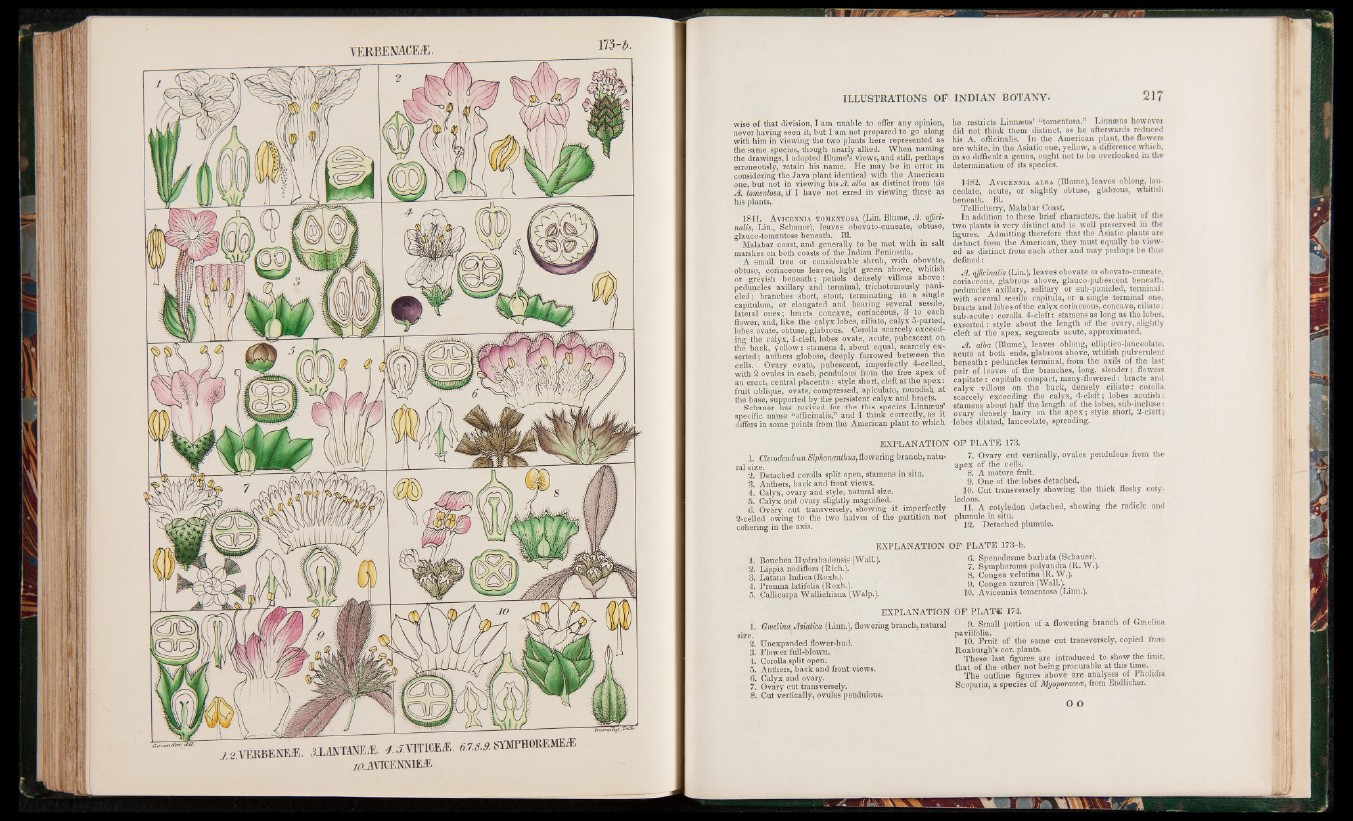
VKRBENACEÆ. m m
wise of that division, I am unable to offer any opinion,
never having seen it, but I am not prepared to go along
with him in viewing the two plants here represented as
the same species, though nearly allied. When naming
the drawings, I adopted Blume’s views, and still, perhaps
erroneously, retain his name. He may be in error in
considering the Java plant identical with the American
one, but not in viewing his A. alba as distinct from his
A, tomentosa, if I have not erred in viewing these as
his plants.
1841. Avicennia tomentosa (Lin. Blume, A. officinalis,
Lin., Schauer), leaves obovato-cuneate, obtuse,
glauco-tomentose beneath. Bl.
Malabar coast, and generally to be met with in salt
marshes on both coasts of the Indian Peninsula.
A small tree or considerable shrub, with obovate,
obtuse, coriaceous leaves, light green above, whitish
or greyish beneath; petiols densely villous above:
peduncles axillary and terminal, trichotomously pani-
cled; branches short, stout, terminating in a single
capitulum, or elongated and bearing several sessile,
lateral ones; bracts concave, coriaceous, 3 to each
flower, and, like the calyx lobes, ciliate, calyx 5-parted,
lobes ovate, obtuse, glabrous. Corolla scarcely exceeding
the calyx, 4-cleft, lobes ovate, acute, pubescent, on
the back, yellow: stamens 4, about equal, scarcely ex-
serted; anthers globose, deeply furrowed between the
cells. Ovary ovate, pubescent, imperfectly 4-celled,
with 2 ovules in each, pendulous from the free apex of
an erect, central placenta: style short, cleft at the apex:
fruit oblique, ovate, compressed, apiculate, roundish at
the base, supported by the persistent calyx and bracts.
Schauer has revived for the this species Linnasus’
specific name “officinalis,” and I think correctly, as it
differs in some points from the American plant to which
he restricts Linnaeus’ “tomentosa.” Linnaeus however
did not think them distinct, as he afterwards reduced
his A. officinalis. In the American plant, the flowers
are white, in the Asiatic one, yellow, a difference which,
i geni
determination
oi its species.
1482. Avicennia alba (Blume), leaves oblong, lanceolate,
acute, or slightly obtuse, glabrous, whitish
beneath. Bl.
Tellicherry, Malabar Coast.
In addition to these brief characters, the habit of the
two plants is very distinct and is well preserved in the
figures. Admitting therefore that the Asiatic plants are
distinct from the American, they must equally be viewed
as distinct from each other and may perhaps be thus
defined:
A. officinalis (Lin.), leaves ob ovate or obovato-cuneate,
coriaceous, glabrous above, glauco-pubescent beneath,
peduncles axillary, solitary or sub-panicled, terminal:
with several sessile capitula, or a single terminal one,
bracts and lobes of the calyx coriaceous, concave, ciliate:
sub-acute: corolla 4-cleft: stamens as long as the lobes,
exserted: style about the length of the ovary, slightly
cleft at the apex, segments acute, approximated.
A. alba (Blume), leaves oblong, elliptico-lanceolate,
acute at both ends, glabrous above, whitish pulverulent
beneath: peduncles terminal, from the axils of the last
pair of leaves of the branches, long, slender; flowers
capitate: capitula compact, many-flowered: bracts and
calyx villous on the back, densely ciliate: corolla
scarcely exceeding the calyx, 4-cleft; lobes acutish:
stamens about half the length of the lobes, sub-incluse:
ovary' densely hairy on the apex; style short, 2-cleft;
lobes dilated, lanceolate, spreading.
EXPLANATION OF PLATE 173.
7. Ovary cut vertically, ovules pendulous from the
apex o f the cells.
8. A mature fruit.
9. One of the lobes detached.
10. Cut transversely showing the thick fleshy cotyledons.
11. A cotyledon detached, showing the radicle and
1. Clerodendron Siphonanthus, flowering branch, natural
size. 4
2. Detached corolla split open, stamens in situ.
3. Anthers, back and front views.
4. Calyx, ovary and style, natural size.
5 . Calyx and ovary slightly magnified.
6. Ovary cut transversely, showing it imperfectly
2-celled owing to the two halves of the partition not plumule in situ,
cohering in the axis. 12. Detached plumule.
EXPLANATION OF PLATE 173-b.
1. Bouchea Hydrabadensis (Wall.). 6. Spenodesme barbata (Schauer).
2. Lippia nodiflora (Rich.). 7. Symphorema polyandra (R. W.).
3. Latana Indica(Roxb.). 8. Congea velutifia (R. W.).
4. Premna latifolia (Roxb.). ■ 9. Congea azurea (Wall.).
5. Caflicarpa Wallichiana (Walp.). 10. Avicennia tomentosa (Linn.).
EXPLANATION OF PLAT« 174.
1. Gmelina Asiatica (Linn.), flowering branch, natural 9. Small portion of a flowering branch of Gmelina
paviifolia.
10. Fruit of the same cut transversely, copied from
Roxburgh’s cor. plants.
These last figures are introduced to show the fruit,
that of the other not being procurable at this time.
The outline figures above are analyses of Pholidia
Scoparia, a species of Myoporacecs, from Endlicher.
O O
. Unexpanded flower-bud.
, Flower full-blown.
, Corolla split open.
, Anthers, back and front views.
. Calyx and ovary.
, Ovary cut transversely.
. Cut vertically, ovules pendulous.
. JL__ if jj> " l l i